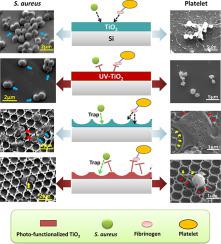Biomaterials Advances ( IF 5.5 ) Pub Date : 2021-02-25 , DOI: 10.1016/j.msec.2021.111996 Yuzhen Liao , Zhi Zhou , Sheng Dai , Lang Jiang , Ping Yang , Ansha Zhao , Lei Lu , Jiang Chen , Nan Huang

|
Titanium dioxide (TiO2) is a widely used biomaterial. It is a great challenge to confer antibacterial and antithrombotic properties to TiO2 while maintaining its cell affinity. Here, we developed a new strategy to achieve the above goal by comprehensively controlling the chemical cues and geometrical cues of the surface of TiO2. Using colloidal etching technology and UV irradiation treatment, we obtained the photofunctionalized nano-micro-honeycomb structured TiO2. The honeycomb structured increased the photocatalytic activity of TiO2, which endowed TiO2 with photo-induced superhydrophilicity to inhibit bacterial adhesion. The high photocatalytic activity also induced the strong photocatalytic oxidation of TiO2 surface organic adsorbates to suppress fibrinogen and platelet attachment. In addition, owing to the micropore trapping-isolation effect on the bacteria and the nano-frames' contact guidance effect on the growth and spreading of platelet pseudopods, the honeycomb structure also shows a considerable inhibiting effect on bacterial and platelet adhesion. Therefore, due to the controlled chemical and geometrical cues' synergistic effect, the photo-functionalized TiO2 honeycomb structure shows excellent bacterial-adhesion resistance and antithrombotic properties. More importantly, the photo-functionalized TiO2 honeycomb did not inhibit the adhesion and growth of endothelial cells (ECs) after culturing for 3 d, indicating a good cell affinity that the traditional antifouling surfaces do not possess.
中文翻译:

细胞友好的光功能化TiO 2纳米微蜂窝,可选择性地防止细菌和血小板粘附
二氧化钛(TiO 2)是一种广泛使用的生物材料。在保持其细胞亲和力的同时赋予TiO 2抗菌和抗血栓形成特性是一个巨大的挑战。在这里,我们开发了一种通过全面控制TiO 2表面的化学线索和几何线索来实现上述目标的新策略。使用胶体蚀刻技术和紫外线辐射处理,我们获得了光功能化的纳米微蜂窝结构的TiO 2。蜂窝状结构提高了TiO 2的光催化活性,赋予了TiO 2具有光诱导的超亲水性,可抑制细菌粘附。高的光催化活性还诱导了TiO 2表面有机吸附物的强光催化氧化,从而抑制了纤维蛋白原和血小板的附着。此外,由于微孔对细菌的捕获-隔离作用以及纳米框架对血小板假足的生长和扩散的接触引导作用,蜂窝结构还显示出对细菌和血小板粘附的显着抑制作用。因此,由于受控制的化学和几何线索的协同作用,光功能化的TiO 2蜂窝结构显示出优异的抗细菌粘附性和抗血栓性。更重要的是,光功能化的TiO 2 蜂窝细胞培养3 d后不抑制内皮细胞(ECs)的粘附和生长,这表明传统的防污表面不具备良好的细胞亲和力。











































 京公网安备 11010802027423号
京公网安备 11010802027423号